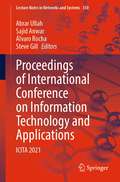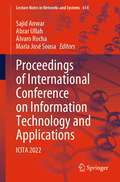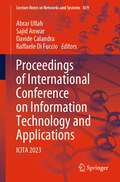- Table View
- List View
Proceedings of Emerging Trends and Technologies on Intelligent Systems: ETTIS 2021 (Advances in Intelligent Systems and Computing #1371)
by Arti Noor Abhijit Sen Gaurav TrivediThis book presents best selected papers presented at the International Conference on Emerging Trends and Technologies on Intelligent Systems (ETTIS 2021) held from 4 – 5 March 2021 in online mode at C-DAC, Noida, India. The book includes current research works in the areas of artificial intelligence, big data, cyber-physical systems, and security in industrial/real-world settings. The book illustrates on-going research results, projects, surveying works, and industrial experiences that describe significant advances in all of the related areas.
Proceedings of Emerging Trends and Technologies on Intelligent Systems: ETTIS 2022 (Advances in Intelligent Systems and Computing #1414)
by Emil Pricop Arti Noor Abhijit Sen Gaurav Trivedi Kriti SarohaThis book presents best selected papers presented at the 2nd International Conference on Emerging Trends and Technologies on Intelligent Systems (ETTIS 2022) to be held from 22 – 23 March 2022 in online mode at C-DAC, Noida, India. The book includes current research works in the areas of artificial intelligence, big data, cyber-physical systems, and security in industrial/real-world settings. The book illustrates on-going research results, projects, surveying works, and industrial experiences that describe significant advances in all of the related areas.
Proceedings of First International Conference on Mathematical Modeling and Computational Science: ICMMCS 2020 (Advances in Intelligent Systems and Computing #1292)
by Sheng-Lung Peng Souvik Pal Rong-Xia HaoThis book presents the most recent scientific and technological advances in the fields of engineering mathematics and computational science, to strengthen the links in the scientific community. It is a collection of high-quality, peer-reviewed research papers presented at the First International Conference on Mathematical Modeling and Computational Science (ICMMCS 2020), held in Pattaya, Thailand, during 14–15 August 2020. The topics covered in the book are mathematical logic and foundations, numerical analysis, neural networks, fuzzy set theory, coding theory, higher algebra, number theory, graph theory and combinatory, computation in complex networks, calculus, differential educations and integration, application of soft computing, knowledge engineering, machine learning, artificial intelligence, big data and data analytics, high-performance computing, network and device security, and Internet of things (IoT).
Proceedings of Fourth International Conference on Engineering Mathematics and Computing: ICEMC 2024 (Lecture Notes in Networks and Systems #1340)
by Dipak Kumar Jana Park Gyei-Kark Prabir Panja Petr DostalThis book gathers selected research papers presented at 4th International Conference on Engineering Mathematics and Computing (ICEMC 2024) at Haldia Institute of Technology, Haldia, India on 7–9 March 2024. This book presents a collection of state-of-the-art research work involving cutting-edge technologies for engineering mathematics and computing. The book presents recent developments in intelligent approaches, including type 3, type 2 fuzzy logic, neural networks, and optimization algorithms, decision making problems, NLP, and their applicability in developing intelligent information systems. The applications of these systems in fields such as pattern recognition, medical diagnostics, time series prediction, intelligent control and robotics, and complicated problems on optimization are also described by authors.
Proceedings of International Conference on Big Data, Machine Learning and Applications: BigDML 2019 (Lecture Notes in Networks and Systems #180)
by Valentina Emilia Balas Sivaji Bandyopadhyay Ripon PatgiriThis book covers selected high-quality research papers presented at the International Conference on Big Data, Machine Learning, and Applications (BigDML 2019). It focuses on both theory and applications in the broad areas of big data and machine learning. It brings together the academia, researchers, developers and practitioners from scientific organizations and industry to share and disseminate recent research findings.
Proceedings of International Conference on Computational Intelligence, Data Science and Cloud Computing: IEM-ICDC 2021 (Algorithms for Intelligent Systems #62)
by Valentina E. Balas Lopa Mandal Joao Manuel R. S. TavaresThis book includes selected papers presented at International Conference on Computational Intelligence, Data Science,, and Cloud Computing (IEM-ICDC 2021), organized by the Department of Information Technology Institute of Engineering and Management, Kolkata, India, during December 22 – 24, 2021. It covers substantial new findings about AI and robotics, image processing and NLP, cloud computing and big data analytics as well as in cyber-security, blockchain and IoT, and various allied fields. The book serves as a reference resource for researchers and practitioners in academia and industry.
Proceedings of International Conference on Computational Intelligence: ICCI 2023 (Algorithms for Intelligent Systems)
by Mario Pavone Ritu Tiwari Mukesh SaraswatThe book presents high-quality research papers presented at International Conference on Computational Intelligence (ICCI 2023) held at Sardar Vallabhbhai National Institute of Technology, Surat, India, during 4–5 November 2023. The topics covered are artificial intelligence, neural network, deep learning techniques, fuzzy theory and systems, rough sets, self-organizing maps, machine learning, chaotic systems, multi-agent systems, computational optimization ensemble classifiers, reinforcement learning, decision trees, support vector machines, hybrid learning, statistical learning, metaheuristics algorithms, machine vision, Internet of Things, image processing, image segmentation, data clustering, sentiment analysis, big data, computer networks, signal processing, supply chain management, web and text mining, distributed systems, bioinformatics, embedded systems, expert system, forecasting, pattern recognition, planning and scheduling, time series analysis, human-computer interaction, web mining, natural language processing, multimedia systems, and quantum computing.
Proceedings of International Conference on Computational Intelligence: ICCI 2024 (Algorithms for Intelligent Systems)
by Mario Pavone Ritu Tiwari Mukesh Saraswat Mukesh ZaveriThis book presents high-quality research papers presented at International Conference on Computational Intelligence (ICCI 2024) held at Sardar Vallabhbhai National Institute of Technology, Surat, India, during 24–26 December 2024. The topics covered are artificial intelligence, neural network, deep learning techniques, fuzzy theory and systems, rough sets, self-organizing maps, machine learning, chaotic systems, multi-agent systems, computational optimization ensemble classifiers, reinforcement learning, decision trees, support vector machines, hybrid learning, statistical learning, metaheuristics algorithms, machine vision, Internet of Things, image processing, image segmentation, data clustering, sentiment analysis, big data, computer networks, signal processing, supply chain management, web and text mining, distributed systems, bioinformatics, embedded systems, expert system, forecasting, pattern recognition, planning and scheduling, time series analysis, human-computer interaction, web mining, natural language processing, multimedia systems, and quantum computing.
Proceedings of International Conference on Computing and Communication Networks: ICCCN 2021 (Lecture Notes in Networks and Systems #394)
by Giancarlo Fortino Deepak Gupta Ashish Khanna Ali Kashif BashirThis book includes selected peer-reviewed papers presented at the International Conference on Computing and Communication Networks (ICCCN 2021), held at Manchester Metropolitan University, United Kingdom, during 19–20 November 2021. The book covers topics of network and computing technologies, artificial intelligence and machine learning, security and privacy, communication systems, cyber physical systems, data analytics, cyber security for Industry 4.0, and smart and sustainable environmental systems.
Proceedings of International Conference on Data Analytics and Insights, ICDAI 2023 (Lecture Notes in Networks and Systems #727)
by Khalid Saeed Nabendu Chaki Nilanjana Dutta Roy Papiya DebnathThe book is a collection of peer-reviewed best selected research papers presented at the International Conference on Data Analytics and Insights (ICDAI 2023), organized by Techno International, Kolkata, India, during May 11–13, 2023. The book covers important topics like sensor and network data analytics and insights; big data analytics and insights; biological and biomedical data analysis and insights; optimization techniques, time series analysis and forecasting; power and energy systems data analytics and insights; civil and environmental data analytics and insights; and industry and applications.
Proceedings of International Conference on Data Analytics and Insights: ICDAI 2024, Volume 1 (Lecture Notes in Networks and Systems #1233)
by Nabendu Chaki Xin-She Yang Sanjay Chakraborty Nilanjana Dutta Roy Papiya DebnathThe book is a collection of peer-reviewed best selected research papers presented at the International Conference on Data Analytics and Insights (ICDAI 2024), organized by Techno International, Kolkata, India, during July 25–27, 2024. The two volumes of the book cover important topics like sensor and network data analytics and insights; big data analytics and insights; biological and biomedical data analysis and insights; optimization techniques, time series analysis and forecasting; power and energy systems data analytics and insights; civil and environmental data analytics and insights; and industry and applications.
Proceedings of International Conference on Data Analytics and Insights: ICDAI 2024, Volume 2 (Lecture Notes in Networks and Systems #1234)
by Nabendu Chaki Xin-She Yang Sanjay Chakraborty Nilanjana Dutta Roy Papiya DebnathThe book is a collection of peer-reviewed best selected research papers presented at the International Conference on Data Analytics and Insights (ICDAI 2024), organized by Techno International, Kolkata, India, during July 25–27, 2024. The two volumes of the book cover important topics like sensor and network data analytics and insights; big data analytics and insights; biological and biomedical data analysis and insights; optimization techniques, time series analysis and forecasting; power and energy systems data analytics and insights; civil and environmental data analytics and insights; and industry and applications.
Proceedings of International Conference on Data Science and Applications: ICDSA 2021, Volume 1 (Lecture Notes in Networks and Systems #288)
by Amir H. Gandomi Sarbani Roy Mukesh Saraswat Chandreyee ChowdhuryThis book gathers outstanding papers presented at the International Conference on Data Science and Applications (ICDSA 2021), organized by Soft Computing Research Society (SCRS) and Jadavpur University, Kolkata, India, from April 10 to 11, 2021. It covers theoretical and empirical developments in various areas of big data analytics, big data technologies, decision tree learning, wireless communication, wireless sensor networking, bioinformatics and systems, artificial neural networks, deep learning, genetic algorithms, data mining, fuzzy logic, optimization algorithms, image processing, computational intelligence in civil engineering, and creative computing.
Proceedings of International Conference on Data Science and Applications: ICDSA 2021, Volume 2 (Lecture Notes in Networks and Systems #287)
by Amir H. Gandomi Sarbani Roy Mukesh Saraswat Chandreyee ChowdhuryThis book gathers outstanding papers presented at the International Conference on Data Science and Applications (ICDSA 2021), organized by Soft Computing Research Society (SCRS) and Jadavpur University, Kolkata, India, from April 10 to 11, 2021. It covers theoretical and empirical developments in various areas of big data analytics, big data technologies, decision tree learning, wireless communication, wireless sensor networking, bioinformatics and systems, artificial neural networks, deep learning, genetic algorithms, data mining, fuzzy logic, optimization algorithms, image processing, computational intelligence in civil engineering, and creative computing.
Proceedings of International Conference on Data, Electronics and Computing: ICDEC 2023, Volume 2 (Lecture Notes in Networks and Systems #1103)
by Nibaran Das Debotosh Bhattacharjee Ondrej Krejcar Ajoy Kumar Khan Swagata MandalThis book features high-quality, peer-reviewed research papers presented at the International Conference on Data Electronics and Computing (ICDEC 2023) organized by Department of Computer Science & Engineering, Mizoram University (A Central University) Aizawl, India & Department of Computer Science & Engineering, National Institute of Technology Mizoram Aizawl, India during 15 – 16 December 2023. The book covers topics in communication, networking and security, image, video and signal processing; cloud computing, IoT and smart city, AI/ML, big data and data mining, VLSI design, antenna, and microwave andcontrol.
Proceedings of International Conference on Generative AI, Cryptography and Predictive Analytics: ICGCPA 2024 (Studies in Smart Technologies)
by Oscar Castillo Valentina Emilia Balas Ahmed A. Elngar Deepali VirmaniThe book presents the proceedings of the International Conference on Generative AI, Cryptography and Predictive Analytics (ICGCPA 2024), held at VIPS-TC, School of Engineering and Technology, Pitampura, Delhi, India, during June 28 – 29, 2024. It covers Generative AI's role in problem-solving, examining applications in image synthesis, content creation, healthcare, and optimization challenges. This book is a valuable resource for postgraduate students in various engineering disciplines.
Proceedings of International Conference on Image, Vision and Intelligent Systems 2023 (Lecture Notes in Electrical Engineering #1163)
by Jun Wang Peng You Shuaiqi LiuThis book constitutes the refereed proceedings of ICIVIS2023, held in Baoding, China, in August 2023. The papers included in the proceedings have been carefully reviewed and selected from the submitted manuscripts in the areas of image, vision and intelligent systems. This book provides a reference for theoretical innovative problems as well as recent practical solutions and applications for the state-of-the-art results in image, vision and intelligent systems. The intended audience of the book includes researchers, professors, experts, practitioners and professionals in the field of image, vision and intelligent systems worldwide.
Proceedings of International Conference on Image, Vision and Intelligent Systems 2024: Volume I (Lecture Notes in Electrical Engineering #1359)
by Peng You Yuhui ZhengThis book constitutes the refereed proceedings of ICIVIS2024, held in Xining, China, in June 2024. This book provides a comprehensive collection of cutting-edge research and innovative solutions in image, vision and intelligent systems. The primary audience consists of academic researchers, industry professionals, and graduate students working in the domains of image, vision, and intelligent systems. This publication serves as an essential resource for those seeking to stay at the forefront of their respective fields, expand their knowledge, and explore new avenues for research and development.
Proceedings of International Conference on Image, Vision and Intelligent Systems 2024: Volume II (Lecture Notes in Electrical Engineering #1362)
by Peng You Yuhui ZhengThis book constitutes the refereed proceedings of ICIVIS2024, held in Xining, China, in June 2024. This book provides a comprehensive collection of cutting-edge research and innovative solutions in image, vision and intelligent systems. The primary audience consists of academic researchers, industry professionals, and graduate students working in the domains of image, vision, and intelligent systems. This publication serves as an essential resource for those seeking to stay at the forefront of their respective fields, expand their knowledge, and explore new avenues for research and development.
Proceedings of International Conference on Information Technology and Applications: ICITA 2021 (Lecture Notes in Networks and Systems #350)
by Álvaro Rocha Sajid Anwar Abrar Ullah Steve GillThis book includes high-quality papers presented at 15th International Conference on Information Technology and Applications (ICITA 2021), held in Dubai, UAE during 13 – 14 November 2021. The book presents original research work of academics and industry professionals to exchange their knowledge of the state-of-the-art research and development in information technology and applications. The topics covered in the book are cloud computing, business process engineering, machine learning, evolutionary computing, big data analytics, internet of things and cyber-physical systems, information and knowledge management, computer vision and image processing, computer graphics and games programming, mobile computing, ontology engineering, software and systems modelling, human computer interaction, online learning / e-learning, computer networks, and web engineering.
Proceedings of International Conference on Information Technology and Applications: ICITA 2022 (Lecture Notes in Networks and Systems #614)
by Álvaro Rocha Sajid Anwar Abrar Ullah Maria José SousaThis book includes high-quality papers presented at 16th International Conference on Information Technology and Applications (ICITA 2022), held in Lisbon, Portugal during October 20–22, 2022. The book presents original research work of academics and industry professionals to exchange their knowledge of the state-of-the-art research and development in information technology and applications. The topics covered in the book are cloud computing, business process engineering, machine learning, evolutionary computing, big data analytics, Internet of things and cyber-physical systems, information and knowledge management, computer vision and image processing, computer graphics and games programming, mobile computing, ontology engineering, software and systems modeling, human–computer interaction, online learning / e-learning, computer networks, and web engineering.
Proceedings of International Conference on Information Technology and Applications: ICITA 2023 (Lecture Notes in Networks and Systems #839)
by Sajid Anwar Abrar Ullah Raffaele Di Fuccio Davide CalandraThis book includes high-quality papers presented at 17th International Conference on Information Technology and Applications (ICITA 2023), held in Turin, Italy during 20 – –22 October 2023. The book presents original research work of academics and industry professionals to exchange their knowledge of the state-of-the-art research and development in information technology and applications. The topics covered in the book are cloud computing, business process engineering, machine learning, evolutionary computing, big data analytics, internet of things and cyber-physical systems, information and knowledge management, computer vision and image processing, computer graphics and games programming, mobile computing, ontology engineering, software and systems modelling, human computer interaction, online learning /e-learning, computer networks, and web engineering.
Proceedings of International Conference on Information Technology and Applications: ICITA 2024 (Lecture Notes in Networks and Systems #1248)
by Sajid Anwar Abrar UllahThis book includes high-quality papers presented at 18th International Conference on Information Technology and Applications (ICITA 2024), held in Sydney, Australia, during October 17–19, 2024. The book presents original research work of academics and industry professionals to exchange their knowledge of the state-of-the-art research and development in information technology and applications. The topics covered in the book are cloud computing, business process engineering, machine learning, evolutionary computing, big data analytics, internet of things and cyber-physical systems, information and knowledge management, computer vision and image processing, computer graphics and games programming, mobile computing, ontology engineering, software and systems modeling, human computer interaction, online learning /e-learning, computer networks, and web engineering.
Proceedings of International Conference on Recent Trends in Computing: ICRTC 2024, Volume 1 (Lecture Notes in Networks and Systems #886)
by Rajendra Prasad Mahapatra Sudip Roy Pritee ParwekarThis book is a collection of high-quality peer-reviewed research papers presented at International Conference on Recent Trends in Computing (ICRTC 2024) organized by SRM Institute of Science and Technology, Ghaziabad, Delhi, India, during July 5–6, 2024. The book is divided into two volumes and discusses a wide variety of industrial, engineering, and scientific applications of the emerging techniques. The book presents original works from researchers from academic and industry in the field of networking, security, big data, and the Internet of Things.
Proceedings of International Conference on Recent Trends in Computing: ICRTC 2024, Volume 2 (Lecture Notes in Networks and Systems #885)
by Sateesh K. Peddoju Rajendra Prasad Mahapatra S. KarthickThis book is a collection of high-quality peer-reviewed research papers presented at the International Conference on Recent Trends in Computing (ICRTC 2024), organized by SRM Institute of Science and Technology, Ghaziabad, held in Delhi, India, from July 5–6, 2024. The book is divided into two volumes and discusses a wide variety of industrial, engineering, and scientific applications of emerging techniques. It presents original works from researchers in academia and industry in the fields of networking, security, big data, and the Internet of Things.
















